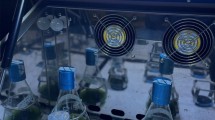Abstract
Cultivation of microorganisms in batch experiments is fast and economical but the conditions therein change constantly, rendering quantitative data interpretation difficult. By using chemostat with controlled environmental conditions the physiological state of microorganisms is fixed; however, the unavoidable stabilization phase makes continuous methods resource consuming. Material can be spared by using micro scale devices, which however have limited analysis and process control capabilities. Described herein are a method and a system combining the high throughput of batch with the controlled environment of continuous cultivations. Microorganisms were prepared in one bioreactor followed by culture distribution into a network of bioreactors and continuation of independent steady state experiments therein. Accelerostat cultivation with statistical analysis of growth parameters demonstrated non-compromised physiological state following distribution, thus the method effectively multiplied steady state culture of microorganisms. The theoretical efficiency of the system was evaluated in inhibitory compound analysis using repeated chemostat to chemostat transfers.





Similar content being viewed by others
References
Bull AT (2010) The renaissance of continuous culture in the post-genomics age. J Ind Microbiol Biotechnol 37:993–1021
Hoskisson PA, Hobbs G (2005) Continuous culture—making a comeback? Microbiology 151:3153–3159
Malek I (1976) Physiological state of continuously grown microbial cultures. In: Dean ACR, Ellwood DC, Evans CGT, Melling J (eds) Continuous culture 6: applications and new fields. pp 1–9
Novick A, Szilard L (1950) Description of the chemostat. Science 112:715–716
Wick LM, Weilenmann H, Egli T (2002) The apparent clock-like evolution of Escherichia coli in glucose-limited chemostats is reproducible at large but not at small population sizes and can be explained with Monod kinetics. Microbiology 148:2889–2902
Ferenci T (2006) A cultural divide on the use of chemostats. Microbiology 152:1247–1248
Paalme T, Kahru A, Elken R et al (1995) The computer-controlled continuous culture of Escherichia coli with smooth change of dilution rate (A-stat). J Microbiol Methods 24:145–153
Kasemets K, Drews M, Nisamedtinov I, Adamberg K, Paalme T (2003) Modification of A-stat for the characterization of microorganisms. J Microbiol Methods 55:187–200
Adamberg K, Lahtvee PJ, Valgepea K, Abner K, Vilu R (2009) Quasi steady state growth of Lactococcus lactis in glucose-limited acceleration stat (A-stat) cultures. Antonie van Leeuwenhoek 95:219–226
Dunn IJ, Mor JR (1975) Variable-volume continuous cultivation. Biotechnol Bioeng 17:1805–1822
Paalme T, Tiisma K, Kahru A, Vanatalu K, Vilu R (1990) Glucose-limited fed-batch cultivation of Escherichia coli with computer-controlled fixed growth rate. Biotechnol Bioeng 35:312–319
Levenspiel O (1998) Chemical reaction engineering, 3rd edn. ISBN:978-0-471-25424-9
Blount ZD, Borland CZ, Lenski RE (2008) Historical contingency and the evolution of a key innovation in an experimental population of Escherichia coli. Proc Natl Acad Sci USA 105:7899–7906
Fricke J, Pohlmann K, Tatge F, Lang R, Faber B, Luttmann R (2011) A multi-bioreactor system for optimal production of malaria vaccines with Pichia pastoris. Biotechnol J 6:437–451
Lueders S, Fallet C, Franco-Lara E (2009) Proteome analysis of the Escherichia coli heat shock response under steady-state conditions. Proteome Sci 7:36
Lara AR, Taymaz-Nikerel H, Mashego MR, van Gulik WM, Heijnen JJ, Ramírez OT, van Winden WA (2009) Fast dynamic response of the fermentative metabolism of Escherichia coli to aerobic and anaerobic glucose pulses. Biotechnol Bioeng 104:1153–1161
Nahku R, Valgepea K, Lahtvee PJ, Erm S, Abner K, Adamberg K, Vilu R (2009) Specific growth rate dependent transcriptome profiling of Escherichia coli K12 MG1655 in accelerostat cultures. J Biotechnol 145:60–65
Valgepea K, Adamberg K, Vilu R (2011) Decrease of energy spilling in Escherichia coli continuous cultures with rising specific growth rate and carbon wasting. BMC Syst Biol 5:106
Dénervaud N, Becker J, Delgado-Gonzalo R, Damay P, Rajkumar AR, Unser M, Shore D, Naef F, Maerkl SJ (2013) A chemostat array enables the spatio-temporal analysis of the yeast proteome. Proc Natl Acad Sci USA 110(39):15842–15847
Nahku R, Peebo K, Valgepea K, Barrick JE, Adamberg K, Vilu R (2011) Stock culture heterogeneity rather than new mutational variation complicates short-term cell physiology studies of Escherichia coli K-12 MG1655 in continuous culture. Microbiology 157:1204–1210
Acknowledgments
The financial support for this work was provided by the European Regional Development Fund project EU29994; Ministry of Education, Estonia, through the grant IUT1927 and Estonian Science Foundation through grant G9192.
Author information
Authors and Affiliations
Corresponding author
Electronic supplementary material
Below is the link to the electronic supplementary material.
Rights and permissions
About this article
Cite this article
Erm, S., Adamberg, K. & Vilu, R. Multiplying steady-state culture in multi-reactor system. Bioprocess Biosyst Eng 37, 2361–2370 (2014). https://doi.org/10.1007/s00449-014-1214-5
Received:
Accepted:
Published:
Issue Date:
DOI: https://doi.org/10.1007/s00449-014-1214-5




